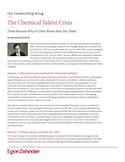The Chemical Talent Crisis
Three Reasons Why it’s Even Worse than You Think.
Every chief executive and board member in the chemical industry is facing the same chronic talent shortage, unable to find enough rising stars at the director and VP level to fill the succession plans for soon-to-retire GMs, country managers and CEOs. It’s tempting to think that these difficulties are just the most recent manifestation of the “war for talent” that has affected all competitive industries for the last twenty years. But beneath the surface, there are three interwoven forces that are combining to make the current talent crisis in chemicals particularly acute. While there are no easy answers, understanding the factors at work provide a starting point for developing new talent strategies.
Reason 1: Disruption has reached the chemical industry
A decade ago, the chemical industry, along with other components of the industrial sector, could largely regard disruption as a problem for media, retail and other sectors vulnerable to disintermediation. But during that time, the extent of globalization has increased and its pace has quickened. U.S. and European chemical companies no longer have a monopoly on innovation and efficiency; there are plenty of counterparts in Asia, India and Latin America that are churning out patents and that have built global enterprises by fulfilling the unmet needs of rapidly growing emerging markets. New technologies have upended a product development pathway based on incremental improvements, and ongoing sustainability concerns have led to a more challenging regulatory environment and new stakeholder concerns. Disruption now has come to us as well.
Most talent management functions are structured on the assumption that past success is an indicator of future performance. That assumption falls apart, however, in the face of the continual, fundamental change now underway. Leaders who do well under relatively stable and well-understood conditions may underperform when confronted with today’s rapid globalization and chronic uncertainty. In this new environment, when the ability to quickly adapt to unforeseen challenges and opportunities is critical, personal qualities such as curiosity and insight go from “nice to have” to “must have.” Few chemical companies, however, have recalibrated their recruiting and development functions to optimize for these and related traits.
Reason 2: Private equity rewrites the rules
If the type of leaders we need has radically changed, the market for those leaders has changed as well. Chemical firms have traditionally viewed hiring from outside as unseemly, preferring instead to develop talent internally, in the same way that labs at engineering schools admit graduate students and teach them the science from the ground up. This rather genteel approach to talent worked so long as everyone played by the same rules.
But the entrance of private equity as a major investor has dramatically changed the game. Along with their capital, private equity firms bring an unapologetically deep-pocketed approach to talent acquisition. They have no hesitation in making an offer to a VP at a rival firm—and doing so with seven-figure pay packages that upend unspoken agreements that held for a generation. As economic historian Charles Kindleberger famously observed, “There is nothing so disturbing to one’s well-being and judgment as to see a friend get rich.” Executives who had happily thought of themselves as lifetime members of a corporate family increasingly see themselves as free agents, and legacy firms, seeped in culture and history, often are uncertain of how to respond against private equity-backed firms that are free of those constraints.
Reason 3: Chronic pipeline and succession problems
Challenges around disruption and compensation expectations are exacerbated by recruiting and succession problems that stretch back thirty years. The major contraction that began in the early 1980s brought two responses with long-term talent consequences. First, entry-level recruiting virtually ground to a halt, shutting off the flow of promising talent from engineering schools. Second, and more importantly, the industry underwent a massive cost-driven restructuring that eliminated a wide band of middle management that was never replaced. As a result, the 40 to 50-year-old cohort that should be filling leadership succession plans today is much thinner than it needs to be. And while entry-level recruiting eventually returned, it did so only to find more and more students flocking to computer science and entrepreneurship programs. Leadership succession thus is likely to be a long-term problem for the industry.
The talent situation isn’t hopeless, but it is complicated and challenging. In future posts we’ll explore various strategies chemical firms can employ to strengthen their pipelines and to develop and retain the next generation of senior leaders. But the first step is having a clear awareness of exactly where we stand.
For more information contact:
Bernhard Scholl
Consultant
bernhard.scholl@egonzehnder.com
+1 305 569 1024






